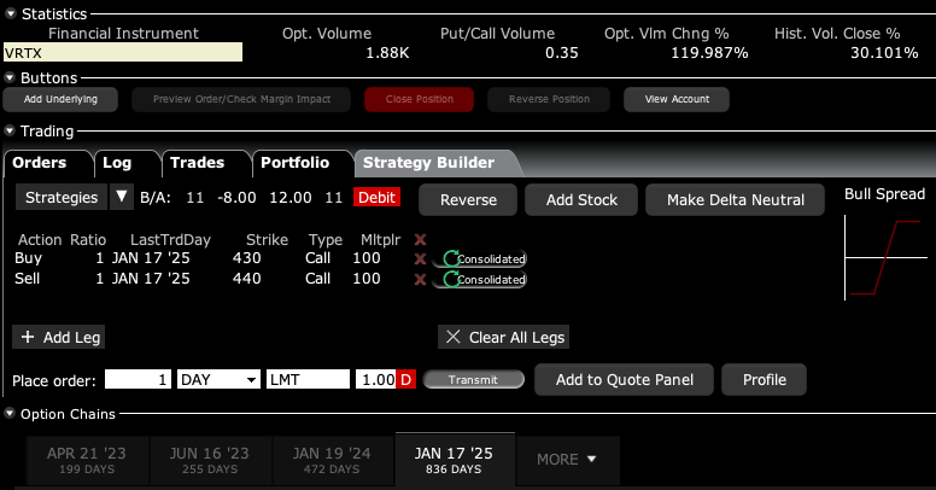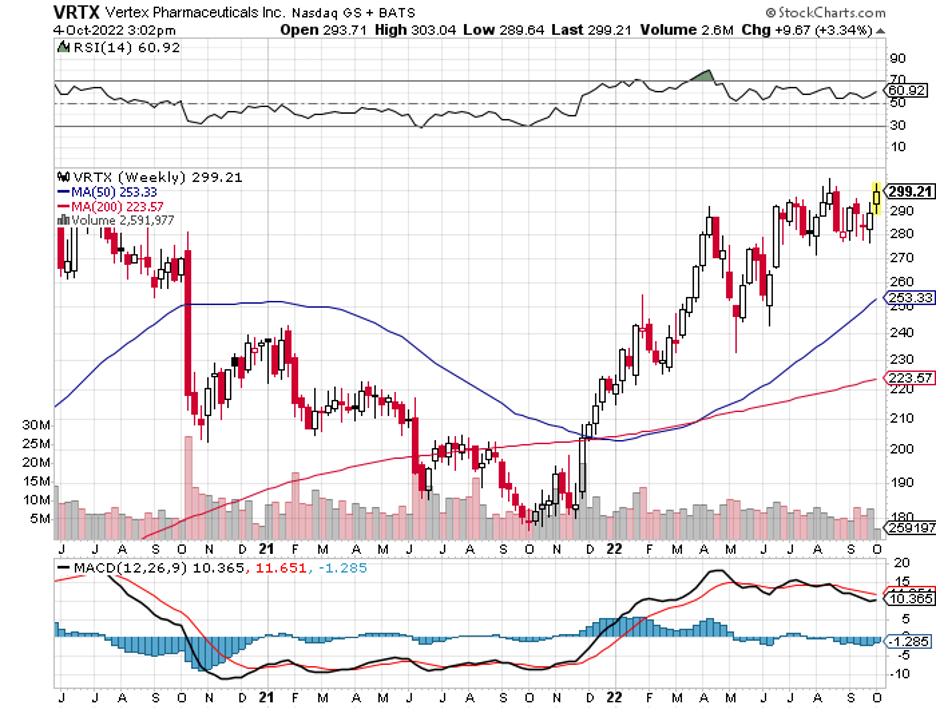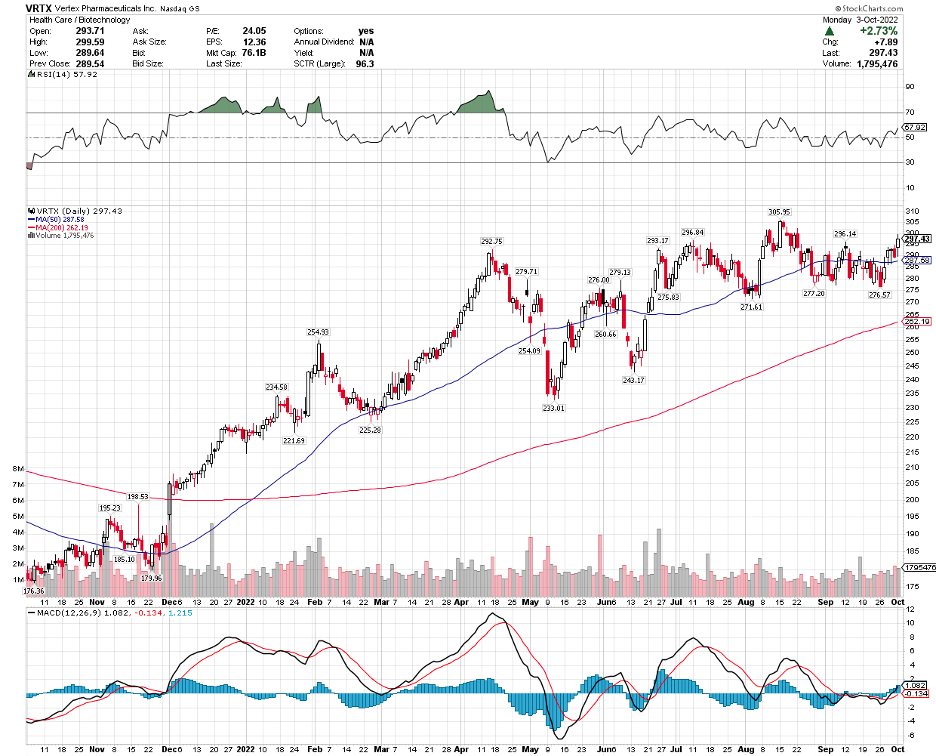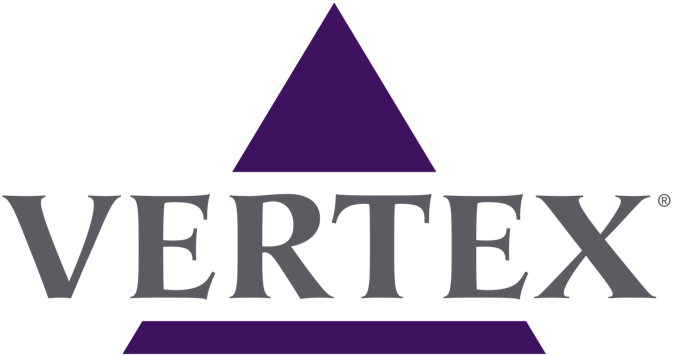When John identifies a strategic exit point, he will send you an alert with specific trade information as to what security to sell, when to sell it, and at what price. Most often, it will be to TAKE PROFITS, but, on rare occasions, it will be to exercise a STOP LOSS at a predetermined price to adhere to strict risk management discipline.


Trade Alert - (VRTX) – BUY
BUY the Vertex (VRTX) January 2025 $430-$440 out-of-the-money vertical Bull Call spread LEAPS at $1.50 or best
Opening Trade
10-12-2022
expiration date: January 17, 2025
Number of Contracts = 1 contract
While the chance of winning a real lottery is something like a million to one, this one is more like 2:1 in your favor. And the payoff is 5.6:1. That is the probability that Vertex shares will rise by 47% over the next two years and four months.
Vertex continues to boost its revenue and profits courtesy of its monopoly in the market for treatments that cystic fibrosis (CF).
The company sells four therapies targeting this condition.
Its latest approval in this segment was for Trikafta, which received the green light in 2019. By 2021, Trikafta was already able to rake in over $5.6 billion in revenue.
Trikafta can be used as a treatment for up to 90% of CF patients. This number goes beyond any of those delivered by other Vertex products. More importantly, Trikafta will keep its patent exclusivity until the late 2030s.
To learn more about the company, please visit their website at https://www.vrtx.com
I am therefore buying the Vertex (VRTX) January 2025 $430-$440 out-of-the-money vertical Bull Call spread LEAPS at $1.50 or best.
Don’t pay more than $2.00 or you’ll be chasing on a risk/reward basis.
January 2025 is the longest expiration currently listed. Please note that these options are illiquid, and it may take some work to get in or out. Executing these trades is more an art than a science.
Let’s say the Vertex (VRTX) January 2025 $430-$440 out-of-the-money vertical Bull Call spread LEAPS are showing a bid/offer spread of $1.50-$2.50, which is typical. Enter an order for one contract at $1.50, another for $1.60, another for $1.70 and so on. Eventually, you will enter a price that gets filled immediately. That is the real price. Then enter an order for your full position at that real price.
A lot of people ask me about the appropriate size. Remember, if this stock does NOT rise by 47% in two years and four months, the value of your investment goes to zero. The way to play this is to buy LEAPS in ten different names. If one out of ten increases ten times, you break even. If two of ten work, you double your money, and if only three of ten work, you triple your money.
There is another way to cash in. Let’s say we get half of your double in the next three months which, from these low levels, is entirely possible. Then you could earn half of the maximum potential profit in months and you can decide whether to keep the threefold return or go for the full five bagger. It’s a nice problem to have.
Notice that the day-to-day volatility of LEAPS prices is miniscule since the time value is so great. This means that the day-to-day moves in your P&L will be small. It also means you can buy your position over the course of a month just entering new orders every day. I know this can be tedious but getting screwed by overpaying for a position is even more tedious.
Look at the math below and you will see that a 49% rise in (VRTX) shares will generate a 567% profit with this position, such is the wonder of LEAPS. That gives you an implied leverage of 5.6:1 across the $430-$440 space.
Only use a limit order. DO NOT USE MARKET ORDERS UNDER ANY CIRCUMSTANCES. Just enter a limit order and work it.
This is a bet that Vertex will not fall below $440 by the January 17, 2025 options expiration in 2 years and 3 months.
Here are the specific trades you need to execute this position:
Buy 1 January 2025 (VRTX) $430 calls at………….………$31.00
Sell short 1 January 2025 (VRTX) $440 calls at…………$29.50
Net Cost:………………………….………..…............……….….....$1.50
Potential Profit: $10.00 - $1.50 = $8.50
(1 X 100 X $8.50) = $850 or 567% in 2 years and 3 months.


To see how to enter this trade in your online platform, please look at the order ticket below, which I pulled off of Interactive Brokers.
If you are uncertain on how to execute an options spread, please watch my training video by clicking here.
The best execution can be had by placing your bid for the entire spread in the middle market and waiting for the market to come to you. The difference between the bid and the offer on these deep in-the-money spread trades can be enormous.
Don’t execute the legs individually or you will end up losing much of your profit. Spread pricing can be very volatile on expiration months farther out.
Keep in mind that these are ballpark prices at best. After the alerts go out, prices can be all over the map.
A Powerhouse Biotech Going Higher
There is no single recipe for building wealth over the years. There are several ways to achieve this goal. However, a particularly effective one is recognizing solid businesses that deliver revenue and profit over time.
You can easily find many excellent candidates in the biotechnology and healthcare world. Actually, a lot of biotech stocks have managed to outperform the struggling market this 2022.
One name that emerged virtually unscathed from the onslaught of economic, political, and financial crises is Vertex Pharmaceuticals (VRTX).
Admittedly, the market downturn has yet to end. That means the company could still experience the effects of macro headwinds and tensions in the near future.
With that said, Vertex is one of the few companies equipped with the right tools to deliver excellent returns in the long run.
One of the reasons Vertex is at the top of the list in the biotech world is its history. The company has been generating solid returns for investors for quite a while now.
In fact, it has impressively surpassed the S&P 500 Index in the past 10 years.
Apart from that, Vertex continues to boost its revenue and profits courtesy of its monopoly in the market for treatments that target the underlying reasons or causes behind cystic fibrosis (CF).
Vertex is the market leader in the CF space worldwide. The company sells four therapies targeting this condition.
The company’s latest approval in this segment was for Trikafta, which received the green light in 2019. By 2021, Trikafta was already able to rake in over $5.6 billion in revenue.
Trikafta can be used as a treatment for up to 90% of CF patients. This number goes beyond any of those delivered by other Vertex products. More importantly, Trikafta will keep its patent exclusivity until the late 2030s.
That provides Vertex with plenty of time to make headway and expand the application of the product to cover previously untapped markets—a strategy that the company has been perfecting over the years.
Vertex has been busy winning approvals in new age groups and more reimbursements in several countries to ensure longer-lasting dominance in this segment.
Recently, the biotech has launched its Phase 3 trials for a candidate that may be an even better product than Trikafta.
While details have been kept under wraps, Vertex shared that the product would be a one-time curative treatment. Needless to say, this would translate to a massive payday for Vertex.
If everything goes according to plan, this new candidate might be launched by the first quarter of 2023.
At the same time, the biotech has been working on promising candidates for much-needed treatment areas, projected to generate billions of dollars in revenue.
This move is aligned with the strategy Vertex has been using over the years: target diseases with only a handful (if any) of safe and effective therapy options.
Among Vertex’s promising but ambitious programs is VX-880, a potential treatment for Type 1 diabetes.
While this could be a long shot, Vertex’s decision to buy ViaCyte for $320 million speaks volumes of the biotech’s seriousness about the endeavor. For context, ViaCyte is a private company focused on developing a functional cure for Type 1 diabetes.
This acquisition enables Vertex to add researchers who have been working on the same goal for years to contribute their expertise to the pipeline. Plus, ViaCyte can bolster Vertex’s manufacturing expertise for cell-based therapies targeting Type 1 diabetes.
Of course, there’s the work with CRISPR Therapeutics (CRSP) to develop gene therapies. Combining this collaboration with ViaCyte’s pipeline, which includes gene-edited cells created to evade the immune system, means Vertex could design a program eliminating the necessity for immunosuppressive therapy.
Meanwhile, there are other solid candidates in the biotech pipeline.
So far, Vertex has been having discussions with the FDA. The company has recently provided proof of concept data for its candidate for Exa-cel in sickle cell disease and transfusion-dependent thalassemia. Given the progress, the product should be slated for release by early 2023.
Another is VX-147, which is a kidney disease candidate that’s currently in crucial development. To date, the product is on track for accelerated approval and could start generating sales by late 2024.
On top of these, Vertex has been working on alternatives for opioids to avoid overdoses. Amid the growing concerns and data on the addictiveness of opioids, these continue to be prescribed as treatments.
This epidemic shows no signs of slowing down, with the CDC’s recent estimate increasing to 75,000 Americans dying from an overdose. According to the CDC, over 2 million Americans are addicted to opioids.
One explanation for this issue is that there is no effective alternative. While Vertex’s initial candidates failed to show an optimal profile, its latest candidate may very well be the answer.
The new candidate, VX-548, was created based on observations and research on families in Pakistan with the rare ability not to feel or experience any pain.
Due to this particular genetic abnormality, members of these families are able to walk on hot coals, get stabbed with knives, and jump from heights, and experience absolutely no pain at all.
The genetic mutation stops the peripheral nervous system from sending pain signals to the brain.
Vertex and other developers like Biogen (BIIB) are attempting to develop drugs that mimic the pain-blocking ability resulting from this genetic mutation.
If successful, VX-548’s greatest asset is its non-addictive potential, thereby making premium pricing more likely justified.
The current market for acute pain treatments annually is $4 billion, and that number is for generic pricing.
Considering that the pricing of a branded treatment would probably be at least double, then the commercial potential is massive.
Over the next 10 years, Vertex is expected to launch new treatments which, combined with its current CF franchise, will propel its earnings, profit, and share price to even higher heights.
It’s currently facing the bear market without so much as breaking a sweat, with stock prices climbing by roughly 28% so far this 2022 compared to the market’s 19% decline. I suggest you don’t wait too long to buy into this top-tier biotech.





